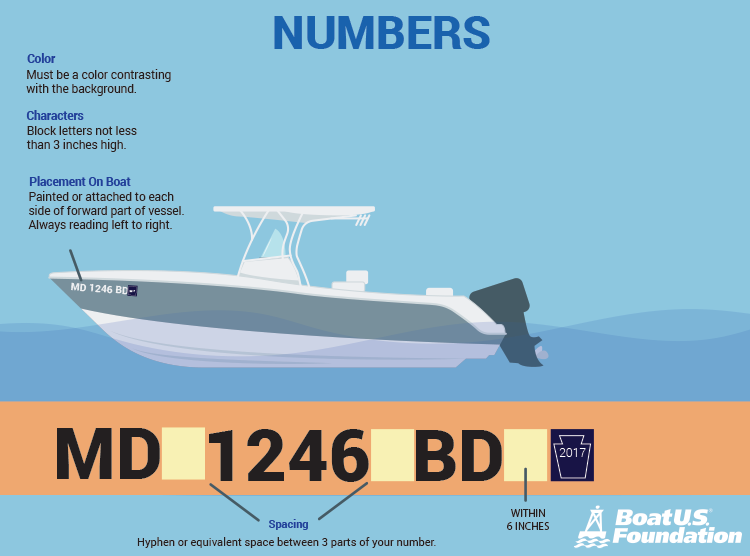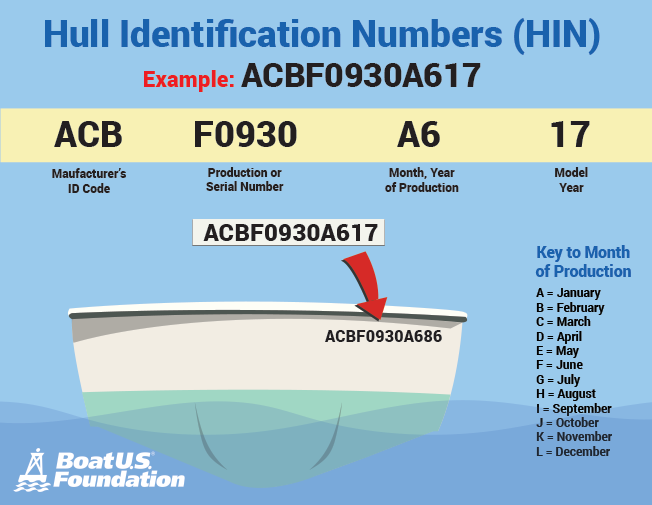Registration Requirements
Know the Law
Boarding Preparations
You've been stopped by the local marine patrol for a routine equipment check. According to your recent Courtesy Marine Exam, you are carrying all required and recommended equipment. But do you know what else marine officers are likely to check?
Numbering and Registration

Just as you wouldn't drive your car without a license plate, current sticker, and registration, your boat must be properly numbered, must have a current state use sticker, and your registration, or "certificate of number", must be aboard. This is a requirement for all mechanically powered vessels, all vessels that travel on federal waters that are navigable, and for vessels that travel on the high seas--virtually every vessel on the water. Boat numbers must be affixed on the forward portion of both the port and starboard side.
Boat numbers must be affixed on the forward portion of both the port and starboard side.
- Numbers should be block letters instead of script
- Numbers need to be at least three inch in height
- The color needs to contrast with the hull color
- The number needs spaces or hyphens between numerals and letters, as: MD 1234 AB or MD-1234-AB
Also, most states require a current sticker immediately after or before the boat numbers on the port side, generally within 6 inches. While most vessels must be registered, some--like canoes and kayaks, may not have to be registered in your state. Also, fees and the length of registration vary from state to state. Many boaters like to carry their boat papers on a floating key ring handle so they will always have them close at hand.
Finally, if you register your boat in your state of residence, but store it or use in another state, you might have to register your boat in that state, or face a fine. Most states have "reciprocity" laws that allow visitation without having to pay a new registration fee for a few weeks or even a few months, but if your boat essentially resides in another state, you should expect to have to register it in that state. For instance, if you live in Pennsylvania, but keep your boat in Maryland and boat on the Chesapeake Bay, you can expect to pay a Maryland registration fee. Check with your state, and the state your boat resides in for specific laws. This reference is included in the state law section of this course.
Hull Identification Number (HIN)

Your vessel will also have (if manufactured since 1972) a Hull Identification Number which is the 12 digit serial number of your vessel. This number is usually located on the upper right portion of the vessels' transom. This number indicates the boat manufacturer, its serial number, and the month and year of production. This number is used to register the boat, and to identify an individual boat.
You may not legally:
- Alter the 12 digit number so that it appears to be a different boat
- Paint over the number
- Obscure the number
- Otherwise destroy, deface or remove the number
Documentation
Another option open to many boaters is to have their vessel federally documented or registered with the US Coast Guard. Documentation has several advantages, but its primary uses are to provide a "paper trail" that establishes ownership of a vessel, and documentation is often necessary to travel overseas.
Some things to remember:
- While federally documented vessels are not required to display state registration numbers, you may still be required to register the vessel with the state, and be required to pay any sales taxes. Federally documented vessels are prohibited from using state boat numbering on the hull, though they can display registration stickers.
- Ships are documented according to use-commercial, recreational, etc. While you may use a commercial vessel for recreational purposes, you may not use a recreational boat for commercial purposes. Doing so will result in the loss of documentation, and fines/penalties.
- Documentation numbers need to be permanently attached to a structural portion of the hull, and the vessels' name and home port need to be listed on the hull--usually the transom. Recreational vessels must have the name and hailing port listed in 4 inch letters. Commercial vessels must do the same, but they must also have the name on both sides of the bow.
Documentation is only available for boats that admeasure 5 gross tons, which works out to be about 30 feet in length. "Admeasurement" is a unit of volume — not weight. A boat that weighs 10,000 pounds might not qualify for documentation.
For more information on documentation, visit the USCG's website for documentation. You can call them at 1-800-799-8362.

